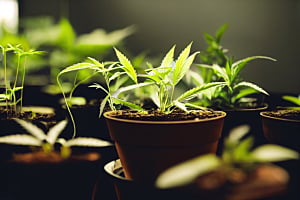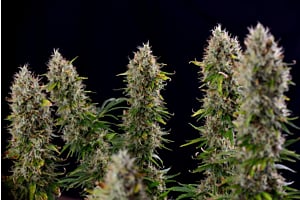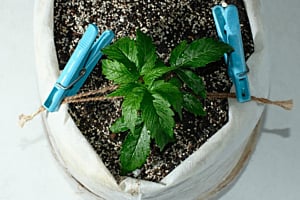Contents
Signs you’re overwatering your plants
How to fix overwatered marijuana plants
How often should you water your plants?
Overwatered weed plants can heal
Do you suspect you have an overwatered weed plant? Excess hydration won’t make your crops glow. Instead, it hinders their growth and causes a variety of symptoms.
The signs of overwatering are similar to other cultivation problems, so it can be challenging to figure out the issue.
Luckily, we know how to tell the difference. If you keep reading, you will too. Learn more about the signs to look for and what to expect with an overwatered weed plant’s recovery.
Let’s get started.
Causes of overwatering
The most common cause of overwatering usually involves the container you plant your germinated marijuana seeds in.
Here are some reasons why this cultivation problem occurs:
Overpotting
Overpotting is when you grow your crops in a container that’s too big for them. It typically leaves you with overwatered marijuana plants due to flooding in the soil. Overpotting causes various issues, including nutrient lockout and root rot.
Putting big plants in small pots
Certain cannabis strains grow well in smaller pots but deliver a lower harvest than usual. The plants need room to spread their roots. If you grow them in an undersized container, moisture gets trapped, leaving you with overwatered marijuana.
Poor drainage
Adequate drainage is essential for all plants. Without it, they’re prone to mold, root rot, and other health problems. All pots should be breathable, so avoid containers made of plastic and other suffocating materials.
Signs you’re overwatering your plants
It’s relatively easy to spot overwatering distress. If the lighting, temperature, and nutrients for cannabis are correct and your plants still display symptoms, excess moisture is typically the culprit.
Here are some red flags to look out for:
Drooping leaves
If the foliage appears full and still curls downwards, it’s usually a sign of overwatered weed. When you see droopy leaves that look wilted, it means you’re not giving your crops enough H2O.
Excess water causes the leaves to become stuffed with liquid, and drooping is usually the first cause for concern. The foliage typically feels firm to the touch, and as it slowly drowns, it may tear or become fragile.
Yellow and brown leaves
Overwatered marijuana leaves sometimes turn yellow or appear brown without wilting. These symptoms signify a nutrient problem, which is a side effect of excess H2O. In some cases, it could be a mineral deficiency.
When you overwater a cannabis plant, it leads to nutrient lockout. The soil becomes too wet and slowly suffocates the roots. The radicles can’t send vitamins to the leaves, causing the new top foliage to turn yellow.
Overwatered weed seedlings turn completely yellow, and overpotting can worsen it. Light stress results in similar symptoms, with mostly the top leaves taking on this hue. If the bulbs are already at the ideal distance, you know it’s the excess water to blame.
Off-color leaves
Yellowing leaves are a significant sign of an overwatered marijuana plant. Another thing to look out for is darker veins, which point toward nitrogen toxicity.
Other possible discolorations may signal overwatering. Look out for:
- Black or brown spots
- Reddish or blue wilted pigments (some marijuana plants, like those grown from blue strain seeds, naturally have discolorations)
- Abnormally dark green leaves
- Fully brown leaves
- Yellowing veins
Many of these symptoms can be confused with other issues, like pH imbalance or light stress. If you know your growing environment is in order and your plants are still drooping, then excess watering is likely the culprit.
Cupping or curling
Leaves that curl or cup are common among overwatered weed plants. You may wonder why weed leaves are curling, and it’s typically because of a lack of drainage.
Excess water pools at the bottom of the pot and affects air circulation. The leaves look similar to those that go through heat stress. When there’s a poor flow of nutrients, crops are more prone to damage from the elements.
Leaf curling appears with other growth problems as well. Here are some signs to confirm it’s caused by overwatering:
- Top leaves curl downwards
- Bottom foliage curls upwards
- Stunted growth
- Soil is wet (not damp) to the touch
Mold
Mold on cannabis is a common problem in many pictures of overwatered marijuana plants. Dampness is the ultimate breeding ground for many pathogens, including powdery mildew and Botrytis.
Excessive hydration causes cannabis plants to become more susceptible to humidity, making it easier for mold to take over. Crops become dampened and soggy with extensive overwatering, forming the ideal environment for pathogens.
Mold develops quickly on some cannabis cultivars, while others resist it. Exposing overwatered marijuana plants from a less tolerant strain to high humidity could cause this disease.
Slimy, twisted, or brown roots
Act fast when the roots become slimy, twisted, or brown, as these symptoms signal severe root rot. They affect overwatered weed seedlings and adult plants and are especially dangerous during flowering.
Cannabis crops experience root rot due to organisms like fungi, algae, bacteria, and parasitic oomycetes. Overwatering and dampness encourage these harmful species.
Poor drainage causes a lack of oxygen and nutritional deficiencies that affect the roots. Even after treating them, the radicles remain brown for a while before healthy new white ones start growing.
Topsoil issues
If you spot any of these signs on your topsoil, you’re likely dealing with an overwatered weed plant:
- Green algae
- Waterlogged soil
- Fungus gnats
- Hardened or solid topsoil (requires immediate treatment)
If the topsoil remains wet, it attracts fungus gnats, which only live in high moisture zones. With recurrent overwatering, the soil hardens and forms dents or holes where you usually pour the liquid.
How to fix overwatered marijuana plants
If you spot any red flags, you may wonder how to save your overwatered weed plant. The prognosis is promising, even with late-stage symptoms. However, treating crops with severe fungal or mold infections is typically more complex.
The easiest way to fix overwatered plants is to let the growing medium dry out for 2–3 days. This process gives the roots fresh oxygen and encourages them to spread out as they search for new air pockets. It also prevents harmful bacteria and moisture-loving pathogens.
If your overwatered weed plants are left untreated, deficiencies may follow. Here’s what to do if things get more serious:
- Check the pH levels. Soil should be between 5.8–6.8, and hydroponics around 5.5–6.5. If these levels are incorrect, you may have a nutrient deficiency caused by a lockout. Use a pH Up or Down solution.
- Flush the soil with alkaline water and apply nutrients or fertilizer accordingly.
- Prune drying or dying leaves. This step allows your plants to use their energy to nourish newer foliage instead of trying to repair parts affected by overwatering.
If your plants get mold or fungal infections, you should determine what you’re dealing with and treat them accordingly. Some conditions are fatal, but in most cases, these steps work:
- Check the pH levels and flush the soil.
- Prune infected sections and throw them far away.
- Use an anti-bacterial, antifungal treatment like neem oil foliar spray.
- Lower the relative humidity levels and increase ventilation.
How often should you water your plants?
Now that you know how to fix overwatered weed plants, it’s vital to implement proper techniques for watering weed. Here’s one way to do it:
- Wait for the topsoil to get dry.
- Water the plants until there’s around 20% runoff. Feel the topsoil again. If it’s dry, repeat.
- Aim to water your crops every 2–3 days. Always check the first inch of soil to determine if you should hydrate your plants. If there is already moisture there, it’s too soon.
Overwatered weed plants can heal
Overwatering is a common problem, but it’s typically simple to fix if you catch it early. When left untreated, you predispose your plants to mold, fungal infections, and root rot. It also becomes significantly more challenging to repair in the later stages.
An overwatered weed plant’s recovery time depends on how early you treat it. Apply solutions as soon as you spot signs like yellowing, droopy leaves, and wet or hard soil. Allow the growing medium to dry out and give it time to adjust to a watering schedule.
Don’t forget to purchase premium marijuana seeds from our store to ensure your cultivation journey is as smooth as possible.

 THC
THC






